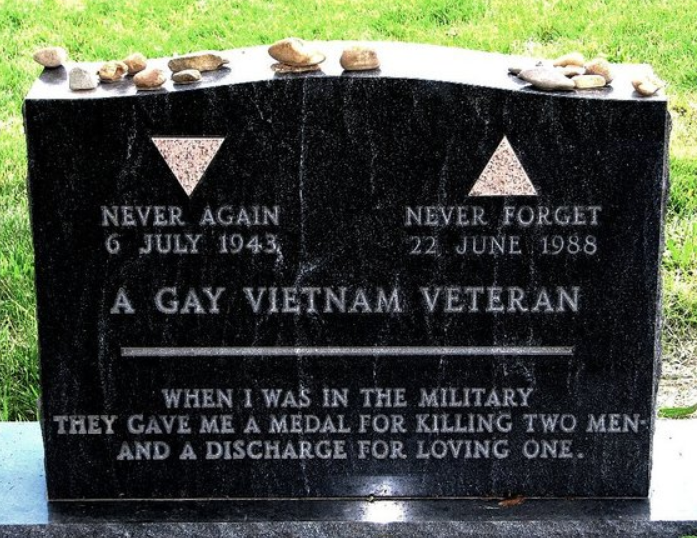
At the Republican National Convention in Cleveland, Ohio last year, Texas Senator Ted Cruz made a powerful and inflammatory statement.
“As we all know, transgender people die of AIDS often,” said Cruz. “They are being buried next to our righteous brothers and sisters of the church…We need to create a spot in the back of the cemetery for them to be laid to rest where they cannot taint our Christian brethren in their eternal rest.”
He was duly beaten down for those comments. “Maybe that idiot [Ted Cruz] should be cremated and spread in a port-o-pot,” said transgender activist Rainey Springs. “We deserve the same dignity in death as anyone else!”
The fight for one’s rights in death is arguably just as important as the fight for rights in life. And the battle to maintain one’s desired sexual identity in death often takes place in a church, as Digital Dying wrote about several months back. But more and more that battle is also moving to the cemetery.
“Cemeteries and graves dramatize the stratification orders of the living,” writes Swedish researcher Eva Reimers. The walls of segregation that mark the world of the living are reaffirmed in death, she says. “In the United States there are often different cemeteries for different ethnic and religious groups and different social classes,” explains Reimers. “To deny someone a grave among others, or individuality at death is a way for society to express repudiation.”
Essentially, we are a nation of walls, and in cemeteries, those walls remain raised. Perhaps in no branch of American life has this fight become as heated as in the U.S. military.
“After consultation with my Generals and military experts, please be advised that the United States government will not accept or allow transgender individuals to serve in any capacity in the U.S. Military,” President Trump tweeted in late July.
The tweet seems to be on its way to becoming formal policy, despite outcry from many high-ranking generals, service members, and activists. Transgender soldiers may not be able to serve in the military, but what happens when they die out of the military? Take the story of Donna Mae Stemmer.
According to Philadelphia Gay News (PGN), Stemmer reached the rank of lieutenant colonel and received 25 decorations, including the Distinguished Service Award and Commemorative Medal in 2008. That same year, Stemmer approached Arlington National Cemetery in an effort to get her headstone to reflect her female name, as well as note an affiliation with an LGBT softball league she participated in in Philadelphia. But the cemetery denied her request. Apparently, “Don’t Ask, Don’t Tell,” the military policy that prevented gay people from serving openly, also prohibited LGBTQ references on military headstones.
That policy was repealed in 2010. Still, “Arlington has a policy to use the veteran’s legal name at the time of death on the headstone,” the PGN article explained. In June 2016, Stemmer died of a heart attack. She was 82. “She was a patriot,” longtime friend Michael Byrne told the paper. “She was very proud to have defended her country.”
But despite her wishes, the name on her headstone at Brigadier General William C. Doyle Memorial Cemetery for veterans in Wrightstown, N.J. reads Donald R. Stemmer. “That makes me very sad,” said Byrne. “I just think it’s a sin that her wishes were not able to be met.”
The blame may not necessarily lie with the military, but the family. “When the family requested a grave marker, they put down the name as Donald R. Stemmer,” a spokesman for the New Jersey Department of Military and Veterans Affairs told PGN. “Nothing was indicated for a name change to Donna. The funeral home also had the name as Donald.”
Simon Davis, reporting in VICE in a July 2017 article, noted that some military cemeteries are actually quite open to the burial of LGBTQ servicemembers. At Washington DC’s Congressional Cemetery, not a 100 feet away from the grave of former FBI director J. Edgar Hoover, who “famously kept files on congressman’s sex lives, especially their affairs with other men,” noted Davis, is the grave of Vietnam War veteran Leonard P. Matlovich, who died from complications of AIDS in 1988. His epitaph, said Davis, reads:
A Gay Vietnam Veteran
When I was in the military, they gave me a medal for killing two men and a discharge for loving one.
“[Matlovich] chose the location of these plots because of their proximity to two notable graves: those of J. Edgar Hoover, and Clyde Tolson,” Ella Morton noted, in an article last year with Atlas Obscura. “Hoover, the first and longtime director of the FBI, waged an anti-gay war during the 1950s and ’60s, spying on suspected gay employees of the government and referring to them as ‘sexual deviates.’ Tolson was Hoover’s longtime colleague, friend, and, according to many, romantic partner.”
“Today,” wrote Davis, with VICE, “a visitor will find a cluster of colorful and unconventional LGBTQ-themed graves located around Matlovich’s.” Inscriptions contain epitaphs such as, “Gay Pioneers,” and “Gay is Good.” The cemetery hands a print-out to visitors that details the graves of 15 notable LGBTQ individuals. Among those on the list is Peter Doyle, a Confederate army veteran, and partner of poet Walt Whitman. Three years ago, the cemetery started hosting docent-led walking tours.
“It almost always fills up,” the cemetery’s program director told VICE. “We’ve had to turn away visitors.”
Clearly, Congressional Cemetery is not trying to hide their transgender tombs away in, “a spot in the back of the cemetery.”









